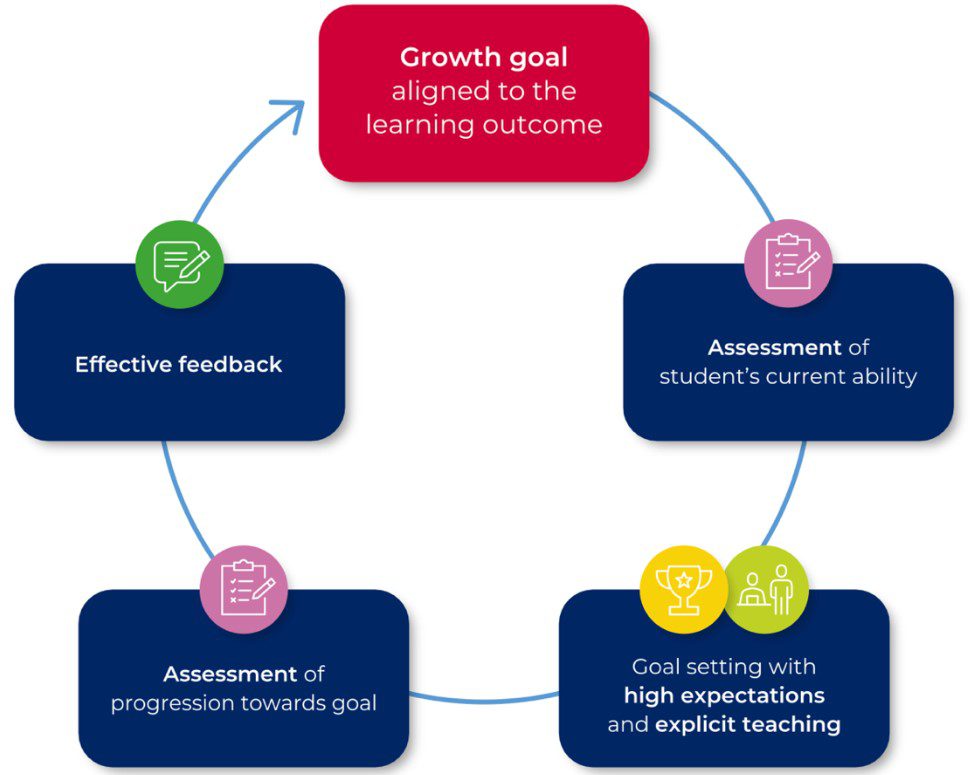Beyond the grade: Cultivating lifelong learners through growth goal assessment in education

Katie Cork, Deputy Head, St Mary’s School, Gerrards Cross, UK
Setting growth goals can improve a student’s academic processes and their outcomes. By emphasising individual skill and knowledge development, they assess both cognitive and non-cognitive factors in learning. By fostering an environment conducive to growth, leaders can ensure that these goals become an integral part of the educational journey.
A growth goal is one that is focused on developing in a skill or a set of knowledge and aims to achieve a level of performance that is better than one’s previous best (Martin et al., 2022). Growth goals are sometimes called ‘personal best’ goals (e.g. Burns et al., 2019), a language often associated with the field of sport. In education, success in academic growth goals is measured in terms of a student’s individual progress in a skill or a subject relative to their past performance, thus encouraging a mindset of learning from mistakes and seeing opportunities for growth, allowing learners with diverse learning needs and paces to identify changes that they can implement to support gradual improvements in behaviours and, ultimately, in assessment outcomes.
Morisano and Locke (2013) identified three key themes of growth goals: personal organisation and time management; emotional and psychological control; and interpersonal skills. For example, a goal to increase revision or improve revision techniques (personal organisation and time management) could be measured by increased time devoted to revision or changes to revision activities. Growth goals therefore assess non-cognitive skills – behaviours, personality characteristics and attitudes (Gutman and Schoon, 2013) – but because these impact cognitive skills traditionally measured by curriculum or skills assessments (Gutman and Schoon, 2013), a growth goal can also incorporate cognitive skills development. Even goals indirectly related to achievement, such as improving stress management, have been found to positively impact academic growth, as well as other outcomes such as wellbeing (Travers et al., 2014), showing how explicitly aligning a goal to an academic attainment is not always necessary in order to increase academic success.
Growth goal assessment celebrates personal bests and continuous learning, aligning with the principles of self determination theory, and offering students a sense of autonomy and competence that is essential for intrinsic motivation and engagement (Ryan and Deci, 2000). Growth goals must be positioned within broader educational standards, so that leaders can ensure that the personal development goals set for students complement the overall educational objectives. Once agreed, integrating individual growth targets with established curriculum standards ensures that students’ personal progress aligns with what they are expected to learn and achieve at their grade level.
How to integrate a growth goal model of assessment

Figure 1: Process of setting and achieving growth goals (New South Wales Department of Education, 2021)
An effective student growth goal is based upon student learning data. This means that student data needs to be collected and analysed before goal setting, to determine where a student is in their learning. The first step is therefore conducting a baseline assessmentWhen referring to early years education, a measurement of a child’s performance conducted within a few weeks of them starting school in Reception, with a focus on literacy and numeracy. to determine performance, which could be both quantitative and qualitative, depending on the goal to be achieved.
Goal setting (see Figure 1) is carried out in collaboration between student and teacher. It is scaffolded through direct instructionA method of instruction in which concepts or skills are taught using explicit teaching techniques, such as demonstrations or lectures, and are practised until fully understood by each student on the concept of growth goals and explicit teaching of metacognitive techniques, such as how students can plan and monitor their work towards the goal and evaluate progress made on a regular (e.g. weekly) basis. For example, students may move from note-taking to quizzing using flashcards, but do they know whether this improves their mastery of the content? Using a reflective diary method (Travers et al., 2014) allows students to develop these metacognitive skills and gain insight into themselves as learners. Regular check-ins and adjustments to the goals throughout the programme assess a student’s progression towards their goal.
Using data effectively is key in tracking the success of growth goals. Leaders should focus on establishing systems for monitoring progress and evaluating the impact of these goals on student outcomes. The duration of any strategy must allow enough time for students to understand and internalise the goals, apply strategies to develop mastery, and see tangible progress in relation to their processes and their academic achievement. Studies on the impact of growth goals typically run programmes lasting between one academic term and one year to measure impact; however, using a formal assessment point such as mock examinations can provide a meaningful starting point with which to identify required growth, with the gap between the mock grade and the desired grade in the external examinations being the growth required.
Research suggests that by adopting a growth goal approach to assessment, school leaders can positively influence an impressive range of outcomes for students. Growth goals have been found to increase academic performance; for example, Morisano et al. (2010, cited in Travers et al., 2014) found a statistically significant improvement in overall grades (30 per cent) in students who had set and reviewed personal best growth goals compared to a control group. Not only this, but growth goal setting has been associated with increased student wellbeing (Morisano et al., 2010, cited in Travers et al., 2014), possibly because it helps in reducing performance anxiety. Growth goal assessments are linked with more positive attitudes towards homework, increased school attendance and decreased drop-out rates, along with increased motivation and engagement (New South Wales Department of Education, 2021). Levels of school engagement have been correlated with both academic attainment in final year assessments (e.g. A-levels) and with educational and occupational achievements in adulthood (Abbott-Chapman et al., 2013). Establishing a growth-goal culture within educational settings is therefore useful in supporting individual student achievements, appreciating each student’s unique learning journey and creating a culture that centres the importance of lifelong learning, encouraging students to continuously seek knowledge and improvement.
What is it that makes growth goals so effective in improving all these measures of student outcomes? As growth goals measure success based on personal progress, they emphasise individual improvement and development of skills and/or understanding, which helps a student to feel some measure of success if they move from an identified baseline or starting point to an increased level of performance via mastery of skills or knowledge (competence). Contrast this with a traditional assessment focusing on attaining a specific standard or performance, such as grades or test scores, where success or failure is more black and white. Growth goals offer a more nuanced view of student development.
Is taking a growth goal approach the right thing to do?
Despite the compelling evidence for a growth goal model of assessment, the use of such an approach is not widespread in the UK. Most of the research into growth goals comes from the United States and Australia, particularly from New South Wales, where the Department for EducationThe ministerial department responsible for children’s services and education in England has identified growth goals as one of the key pedagogies for schools to adopt. Why, then, is it so little used in the UK?
The answer may be a lack of awareness about the concept, and I hope that this article will do something to address this point. Even with greater awareness of the evidence, adopting a more nuanced system of assessment based on growth may prove challenging. Shifting the culture of assessment from assessing and reporting on current performance at a given time to growth over time may clash with the expectations of teachers, parents and students, requiring extensive and active collaboration, and open communication between leadership and stakeholders to create a truly shared sense of purpose (Robinson, 2017). A new system needs new resources like technology and personalised learning tools, along with significant training for staff on how to set, track and provide feedback to ensure consistency and reliabilityIn assessment, the degree to which the outcome of a particular assessment would be consistent – for example, if it were marked by a different marker or taken again in setting meaningful, appropriate growth goals for each individual student.
This latter idea is particularly relevant, as the role of the teacher is pivotal to the success of setting growth goals. The process works well when there is positive collaboration between student and teacher, as a student’s goal setting ability is affected by their perception of support received from their teacher in the learning and teaching (Eberley et al., 2011). Student variables will also affect the impact of the outcome: students need to engage in a meaningful way for growth goals to support outcomes, and this engagement will vary. Students who are more ‘surface’ learners (Biggs and Tang, 2011) are interested in doing what is needed to achieve the mark that they want (often just a pass), and will be less likely to actively engage in the self-reflection needed to set meaningful, challenging goals, whereas ‘deep’ learners see an intrinsic value in activities that create meaning and develop understanding (Biggs and Tang, 2011). Not all students will engage in goal setting in a meaningful and productive way.
Despite the challenges of implementing such a paradigm shift, the evidence is clear: growth goals not only enhance academic performance but also bolster wellbeing and long-term engagement.
- Abbott‐Chapman J, Martin K, Ollington N et al. (2014) The longitudinal association of childhood school engagement with adult educational and occupational achievement: Findings from an Australian national study. British Educational Research Journal 40(1): 102–120.
- Biggs J and Tang C (2011) Teaching for Quality Learning at University. Maidenhead: Open University Press.
- Burns EC, Martin AJ and Collie RJ (2019) Understanding the role of personal best (PB) goal setting in students’ declining engagement: A latent growth model. Journal of Educational Psychology 111(4): 557.
- Eberley MB, Holley EC, Johnson MD et al. (2011) Beyond internal and external: A dyadic theory of relational attributions. Academy of Management Review 36(4): 731–753.
- Gutman LM and Schoon I (2013) The impact of non-cognitive skills on outcomes for young people: Literature review. Education Endowment Foundation and Cabinet Office. Available at: https://discovery.ucl.ac.uk/id/eprint/10125763/1/Gutman_Schoon_%202013%20Non-cognitive_skills_literature_review_.pdf (accessed 14 December 2023).
- Martin AJ, Burns EC, Collie RJ et al. (2022) Growth goal setting in high school: A large-scale study of perceived instructional support, personal background attributes, and engagement outcomes. Journal of Educational Psychology 114(4): 752.
- Morisano D and Locke EA (2013) Goal setting and academic achievement. In: Hattie J and Anderman EM (eds) International Guide to Student Achievement. Abingdon: Routledge, pp. 45–48.
- New South Wales Department of Education (2021) Growth goal setting – what works best in practice: A practical guide for schools. Centre for Education Statistics and Evaluation. Available at: https://education.nsw.gov.au/about-us/education-data-and-research/cese/publications/practical-guides-for-educators/growth-goal-setting (accessed 14 December 2023).
- Robinson V (2017) Reduce Change to Increase Improvement. Thousand Oaks, CA: Corwin Press.
- Ryan RM and Deci EL (2000) Self-determination theory and the facilitation of intrinsic motivation, social development, and well-being. American Psychologist 55(1): 68.
- Travers CJ, Morisano D and Locke EA (2015) Self‐reflection, growth goals, and academic outcomes: A qualitative study. British Journal of Educational Psychology 85(2): 224–241.










